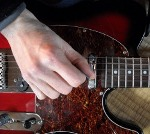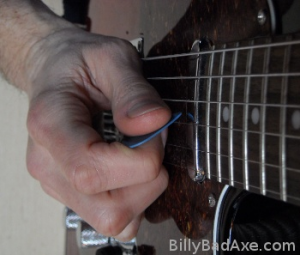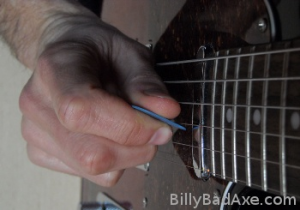For awhile now I’ve been wanting to play the lead solo to Stairway (studio version), which is not a particularly fast solo, but my speed just wasn’t up to snuff. After learning the notes for the first few sections right before the fast lick high on the neck, I began practicing using a metronome to slowly ramp up my speed. I’d play it slow and accurate repeatedly, then progressively faster until everything fell apart, then back off the speed a bit, then rinse and repeat, always trying to play fast and clean.

I made some progress, and reached a point where my speed was better, but I felt like I couldn’t go any further. I just wasn’t fast enough. In fact, I sounded awful. Nothing felt fluid. So I started thinking my picking technique was bad. After a few months of research and testing deep in the underground billybadaxe.com guitar testing facility (actually just me sitting on a cheap computer chair in front of a linux box), I’ve found what is starting to work for me. And hopefully might help you to start to learn how to play lead solos faster using better right hand pick technique.
These ideas about playing faster, better, more smoothly with better right hand technique are not mine. They are the ideas of excellent guitarists all over the net. More importantly, excellent guitarists who actually have the ability to convey clearly what proper fast picking technique looks like. Most experts in any field have a hard time telling you the exact technique that makes them great. They just do it. Which doesn’t help a guitar hack like me. I gotta have specific details.
I’ve been watching youtube vids, reading websites and quizzing my guitar friends and teachers and testing this stuff for the last few months. It all started with me switching to an unanchored right hand position, but there’s more to it.
Proper right hand technique is only part of the play fast puzzle. Once you’ve got good right hand technique, then you’ve got to get the right and left hands in sync and practice, practice, practice.
Please know that this method here is starting to work for me, that is all I can tell you. Will it work for you? I hope so, but you’ll have to give it a shot. Also, if I recommend doing it this way or that, it doesn’t mean that there isn’t a better way some other guy is doing it. Without further ado…
How to play faster, better, smoother with “proper” right hand technique:
Use correct up/down pick angle:
The point of the pick should aim straight down towards the body of the guitar. The top of the pick should not be angled downwards, which makes a down picking easier and up picking difficult. Conversely the top of the pick should not be leaning up, which would make upstrokes easier and down strokes more difficult.


If there was a line running from the point of the pick straight up through the top of the pick, it would be perpendicular to the body of the guitar, a 90 degree angle to the body.
Then rotate pick to 45 degrees:
With the pick in it’s correct alignment from step one, rotate the pick 45 degrees. Your thumb should rotate downward, all the while keeping the correct 90 degree up/down angle from step one.

Use a thick, stiff pick.
Over 1mm is a good rule of thumb. But really, any pick that doesn’t “flap” when you hit a note is fine. Thin, flexy picks take too much time bending while trying to hit a note.
Hold the pick between your index and thumb.
Keep remaining fingers lightly curled in and out of the way. The key here is that the curled index and thumb position sort of restricts movement here. We don’t want the fingers moving the pick.
Use your wrist’s natural hand wave motion to pick notes.
The big wrist muscles, not the thumb and finger, are designed to move back and forth quickly. So make sure your thumb and index finger are used only to adjust the step 2 pick rotation angle and nothing else. Let the wrist be the up down motion to hit notes. This tip came from the excellent article by Mark Wingfield here.
Move everything up and down without anchoring.
Now, with our pick constantly in the correct up/down (90 deg.) and rotational angle (45 deg.), and using our wrist to move the pick up and down, move this whole “assembly” up and down to access higher and lower strings. This means you can’t anchor your pinky or palm anywhere on the guitar.
For higher pitch (thin) strings, rest the side of your thumb and palm on the lower pitch (thicker) strings. As you move toward the thicker strings, move your arm upwards and rest your palm on the body of the guitar above the low e.
Moving the pick hand up and down to play different strings really helped me. I could play the higher pitch strings ok, but if my palm was anchored, when I rotated up to play the lower pitch strings my pick angle naturally went flat making it hard to play. By moving your picking hand up and down, your pick will stay in the perfect position for all strings.
Practice this slowly at first
while you practice keep a sharp eye out that the angles are correct. I’ll stop and hold my right hand still and then look down the neck of the guitar to make sure my up/down pick angle is correct. Then look straight down on my pick hand to make sure my 45 degree angle is correct. I like to just mute the strings with my left hand and hit notes with my right. Do three or four notes per string and move up and down from high e to low e.
How do i know if i’m doing it right?
If you practice this and really try to get all the parts working together with nothing left out, you’ll suddenly find that hitting notes will become easier. Once you hit that moment when you are smoother and hitting notes just seems fluid and easy, then you know you are doing it right. When hitting notes feels difficult and the pick is sticking to the strings, then stop and slowly go through the steps again. Carefully reinspect your technique. Angles ok? Wrist motion moving the pick? Not anchoring? Proper technique will put you in that “everything feels right” zone. Once you feel it, you won’t stop until you’ve got it full time.
Proper technique is a critical part of playing fast
when i played tennis there were times when i could hit the ball as hard as i wanted and never hit it out of bounds. Everything felt right and i could control the ball. The moment things didn’t feel right and i was spraying balls all over the place, my coach would watch and usually find one small thing wrong with my technique. Oh, forgot about stepping into the ball and following through. Once the technical mistake was corrected, i was back to hitting the ball well.
Same with guitar right hand picking. If your technique is spot on and all steps are correct, you’ll get into the zone. Be mindful of the small details: pick angles, wrist motion, keeping the thumb and finger fixed, using your arm to move your picking hand up and down. If one is forgotten, it’ll throw a wrench in the works.
Consider using the classical position to hold the guitar
classical position is left foot raised with guitar resting on left leg. Some of the shredder guys use the classical position. I like how the guitar is angled up a bit so it is easier for me to get into my perfect 45 deg. Pick angle with the right hand, and it’s easier on my left hand because i’ve got better access to the whole neck.
Hopefully this helped you!
This is my new right hand method. I hope you found something here you can use to help your guitar playing as well. Please let me know if this helped, or not! with a family-friendly comment below.
Here are a few resources that inspired this post that might help you on your quest for speed:
https://www.markwingfield.com/teaching_pages/articles/pic.html







This is very useful , thanks!
Thanks for the comment. I hope it helps you get a little more speed going.
Very good nicely presented. was wondering about whats the secret of yngwie. his hand moves along the strings while keeping his wrist and hand parellel as whole. Thanks
Yep, one of the masters for sure. I’ll have to check out his wrist / hand movements. Thanks for the comment.
https://www.youtube.com/watch?v=7TnddE2k598
Your technique will get you to moderate speed, but you’ll need to intentionally slant the pick (what you called an “upward” or “downward lean”) in order to go really fast. This is described in depth by Troy Grady’s series, “Cracking the Code.” Check out Season #2, Episodes #1 and #2, on Yngwie Malmsteen (they’re about 20 minutes each). The major idea is that when the pick reciprocates it goes in and out of the plane of the strings… if this doesn’t make sense, Grady will make it clear.
thanks for the vid link. interesting stuff!
Is it not contradictory to say that a player should not anchor but that they should rest their hand on the strings? And how does one rotate their wrist (as if waving) when their hand is resting on the strings? Would resting it not prevent the rotation?
Hi Bill, If you just lightly rest the palm on the strings you can still move your pick hand up and down vertically. There’s no right way.
I have been trying speed drilling practice since last 2-3 three years in the angle of 90 degree but it gets stick and sometimes and not working properly. what you have mentioned of moving the hands to 45 degree downwords. But i sometimes plant my palm on the bridge and use 45 degree upwords it works good but is it good method.
Thank you for passing along those tips.
Hi Shawn, hope those tips help you get a little faster! dave
Thanks for your information. is this so helping to the beginner like me.
Pick slant simplified: Slant the pick down when you are playing down strokes on the down beat (up strokes are plucked on the up beat obviously, with the pick still slanted down). Slant the pick up when you are playing syncopated up strokes on the down beat (down strokes are plucked on the up beat, with the pick still slanted up).
Nicely written. You may get faster by cutting the picking tip of your tip into 90 degrees angle. Most picks are either wider angles with too large diameter or some can be too sharp angle. 90 degrees with small diameter of the tip lest you pick fast with precision and also helps levelling up occasional changes in the angle of your wrist rotation. M
That “45 degree angle” mantra might work with heavily distorted sound where the fundamental guitar tone is already long gone, but it will sound very bad with clean tone, I prefer to have my pick relatively parallel with the string. The trick is to let it wobble a bit by itself.
Keeping the pick completely parallel to the strings is fine if you don’t really play anything fast, but if you want any sort of real speed at all than keeping it parallel is not very effective. Your pick will end up being harder to get through the strings, it will catch. Especially if you’re putting more than a millimeter or two of the pick through the strings, you want only the very tip. When it comes to tone, yes the angle of the pick does alter the tone a bit, but not so much that just angling it will make you sound horrible. If your tone is horrible than I seriously doubt it’s your pick angle causing it.
I checked online and found a Japanese guitar player who represents a way to remove tension of his arm and wrist: when he does down picking and up picking, he is actually drawing a circle on the string with his pick. If you look at you right hand when you’re playing, you can see you are drawing a timewise circle. I found that this way removes wrist moving and it can remove much tension of my arm and wrist. I think I will give it a try and see if I can play clean and solid note faster. Hope this helps. Will report resutls soon.
Hi – congratilations to the author for getting so many good tips in one place :). I just want to say that these tips really work well – I’ve been playing for about 25 years, had my ups and downs – about 10 years ago I switched my right hand to “float on the strings” with 45 degree of the pick and it really made the difference. Not only the speed, but most important – the tone. First of all – if you have the pick parallel to a string, then you have less ways to control the tone and volume – less tones are possible. With a right pick there’s no problem to have a snappy (or any other) tone with “45 or similar” degree. Small picks (like dunlop’s jazz ones), firmer grip – you controll “snappiness” with slight angle changes + pick grip strength (that changes volume also, you can create accents during fast playing just be squeezing the pick stronger – no dynamics change in hand movement). With decent pickups and strings it works well and gives you more possible tones. Base position – 45 degrees (fastest with repeatable tone on strings with different width), small changes of the angle only (you don’t have to have “full speed” all the time – you can change a little for tone variants). You must be aware of your angle all the time (change it “on purpose” only). It’s one of your controls. Another tip for the speed – forearm skin can stick to the guitar (depends on the guitar) and slow down during really fast strings changing – long sleeves are the answer then. The force needed to move arm up/down while switching string should be the same for all strings (if you rest your skin/flesh that will vary and you won’t be in time). I already mentioned pick grip strength control – it affects the speed also, play with it, controll, change. While playing really fast there’s no way to control volume and tone by the strength of picking movement – it must be consistent to be in time; so – pick grip strength and angles are your potentiometers (angle – close to 45 of course, small changes only) Practice stopping the pick on the next string before picking it. Base position with no sound – pick is resting on a string. While doing “turns” (down/up direction changes) on multiple strings do two things at the same time on the last string – pick by floating the whole hand down (if you’re moving down and want to turn back) and turn wrist just a little up (towards the thumb) – that’ll help with muting the “before last” string and will make the turn smoother (you can sound better when playing faster). Anyway – great article, good tips – good research
I’m left handed and find difficulty with fast picking Which I think it is how I hold the pick Any help for us lefties
45 degrees angle is way too much if you want a snappy attack. Particularly critical with clean tone, but I guess you don’t care much about that, Mr Badass. I have another good tip regarding picking: Start with the pick resting on the string, and let the string glide off the tip of the pick. It’s more of a vety close “rubbing” sensation than anything else. This takes some firmness of the grip, of course.
I “float” as well, in that my hand moves up and down depending on the string that is being played. The most important thing in my book, in order to achieve a precise picking depth, and to avoid extraneous movement, is to have a really firm support with your forearm against the guitar body. I ket the forearm push the guitar towards the side of my body somewhat. The flesh in the forearm allows me to move my hand, as long as I find a good sweet spot for it.
Thanks, this is very helpful. I’m a beginner trying to get my technique developed without learning ‘bad habits’
Noticeable improvement immediately after applying the technique. Took minimal time to readjust to this position and I felt stronger. Thank you!
There’s nothing wrong in planting the bone on the pinky side of the palm just above the wrist to the bass side of the bridge as a pivot and reference point. It actually helps you control the movement of the hand when it gets really, and I mean REALLY, fast. Keep the fingers not holding the pick in a loose fist. Check out some clip with Claus Levin on YouTube, he uses this approach, and he’s one of the fastest and most precise straight alternate pickers out there.
Dave, thank you for a well-written and thorough explanation of proper picking technique. We appreciate your concise insight, drawn from experiences to help others master the craft of proper guitar technique. You rock!
Picking that emulates the action of a violin bow over strings will give you the best tone….this is just logic, you want to hit the string and slide over, and not get too muck pick on that string. I was having trouble with speed and tone until I changed my style to more of a 45° or vertical angle…… depending on the tone and the speed. It immediately doubled my speed and the clean tone even in small parts was amazingly better especially in slow melodic passages.
Billy is exactly right…….thanks
Great article. I’ve been playing for 50 years and still learned a thing or two.
So, do you have any success playing muted on the high E string using this approach, without twisting the hand position considerably? I think not. Furthermore, your hand bends up from the wrist, if you look at the hand sideways. I try to keep my wrist straight, if not arched. This is much more relaxed for the wrist. I also rest the whole of the pinky side of the palm lightly against the bridge or strings, leaving a small gap for the played string. Then it takes just a small adjustment to play muted.
Great article thank you for sharing all that information. Also worth noting is that when you use the pick in a 45 degree angle like that, noise distorts a little differently, depending on the location of where you strike the string in relation to the pickups. Not really noticeable for anyone but guitarists though lol.